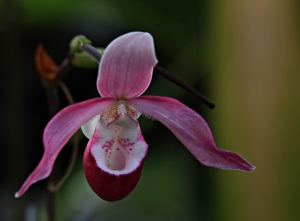General Orchid Care
“Not all orchids are easy to keep, but neither are all of them difficult,” says certified horticulturalist Emily Stull of Sophia Sky Designs, who has kindly put together some easy do’s and don’ts for those who would like to learn about these sensitive plants. She adds that the type you should look for depends both on your experience level and on the conditions of your home. Some orchids like it cooler, but others prefer hotter temperatures. Because of this, it’s important to do research on what your particular plant needs.
If you’re interested in how to keep your orchid healthy, why you keep killing it, or how to start growing them, check out these tips.
______
DO:
- Do remember to dilute your light, such as by using gauzy curtains. All orchids, whether they like bright conditions or relatively dark, require that that light be diluted to prevent sunburn.
- Try using special orchid potting mix (not the regular type). These plants require more ventilation and less water-holding capabilities.
- When your orchid’s leaves are covered in a fine, powdery white coating – which comes from dust or minerals in your water – use distilled or filter-softened water.
- Watch your water: Water that is too hard can be detrimental to more sensitive types of orchids. A “beginner’s level” orchid most likely won’t be affected by it, though, and it can even be beneficial due to the added calcium.
- Do ventilate well: Orchids require good ventilation. A slow moving ceiling fan is best, but a small fan facing away from the plant(s), or a partially open window will also work. Don’t create too strong a draft, e.g. by opening two windows across the room from each other.
- Know if you need a “resting period,” as some orchids require periods of rest where you water and fertilize them very little. Make sure you know if your type of orchid requires this.
- Consider starting slowly. It’s best to buy cheaper plants at first to experiment, and then to venture into expensive and exotic varieties when you have more experience.
DON’T:
- Don’t over-water your orchids. This is the easiest way to kill it.
- Don’t over-fertilize, either. Orchids grow naturally in places where few nutrients are available, and as such – in a home environment – require only a little fertilizer at a time. Try once a week in the summer, or once a month in the winter. To coax out a bloom, you can use a fertilizer with more potassium as the bloom time approaches, which hardens new growth.
- Don’t put your plant in too large a pot, as this will cause the roots to rot. Orchids actually prefer to be in a pot that is just large enough for the plant. When it either outgrows its container, or the compost begins to decay, you know it’s time to re-pot.
- Finally, don’t give up! If your orchid doesn’t flourish, it may simply be that your conditions aren’t right for it, not that you can’t grow them. Keep experimenting and persevering, and eventually you’ll get it!
Four Easy Orchids to Think About:
Brassia: AKA the Spider Orchid

Requirements: Bright light; cool to medium temperatures for popular varieties.
Winter Care: Two months of “rest period” (which means less water and fertilizer at that time).
Cattleya

Requirements: Bright light; intermediate temperature conditions; water freely BUT allow to dry out.
Winter Care: Give at least six weeks with only enough water to prevent the pseudobulbs (the bulbous part from which the leaves and flowers sprout) from shriveling up.
Phalaenopsis: AKA the Moth Orchid

Requirements: Relatively bright light; water year round; warm conditions; no resting period required. The most commonly seen orchid, phalaenopsis is often considered a beginner’s type, although it can be somewhat finicky.
Paphiopedilum: AKA Lady Slipper Orchids (Asian type)

Requirements: Usually less light than other orchid species; water year round; can survive in cool, intermediate, or warm temperatures depending on type.
Winter Care: No resting period is needed, but a reduction of water in winter is recommended.
Did You Know?
- Some orchids are night-scented: This means they produce scent to attract night-time pollinators, such as moths.
- Orchids can grow to be a hundred years old, if properly cared for.
- It takes seven years to get an orchid to blooming size. This accounts for the expense of many store-bought orchids, as they take up green-house space for quite a long time.
- Lady-Slipper orchids are pricey due to the fact that they cannot be propagated by tissue culture; therefore, they can only be divided or grown from seeds.
- Maryland has around 28 native species of orchids.
- Not all orchids are tropical, and many don’t flourish in hot weather.
- The orchid family is one of the most diverse in the world, ranging everywhere from Europe to Alaska.
- Orchids have some of the most complex pollination strategies of any plants. These include (but are not limited to):
Capture—here, the pollinator is attracted into a pouch. The insect falls in and is able to leave by a single exit, which can be reached only by passing the reproductive organs.
Mimicry—in mimicry, the flower has evolved to look and sometimes smell like a pollinator. For example, the Oncidum orchid looks like a group of angry bees. This makes other bees attack them and inadvertently pollinate them.
This slideshow requires JavaScript.
Further Reading:
The Orchid Expert, by Dr D.G. Hessayon





